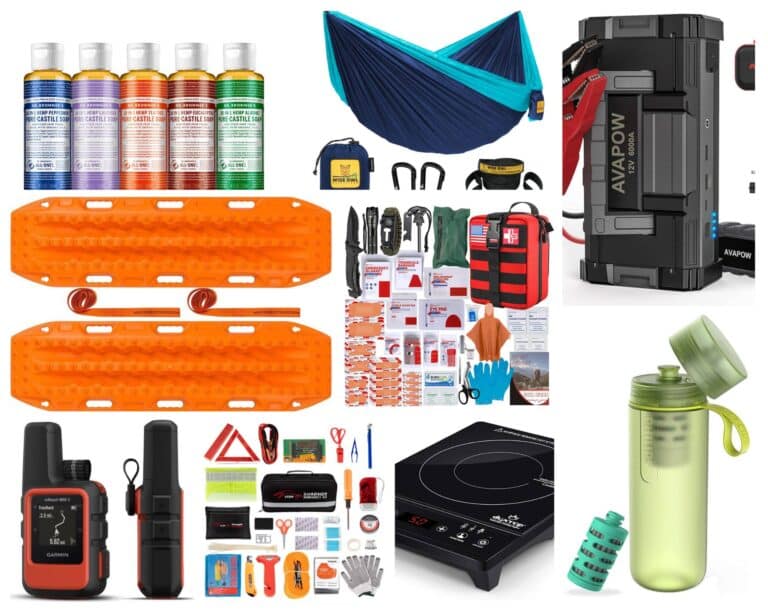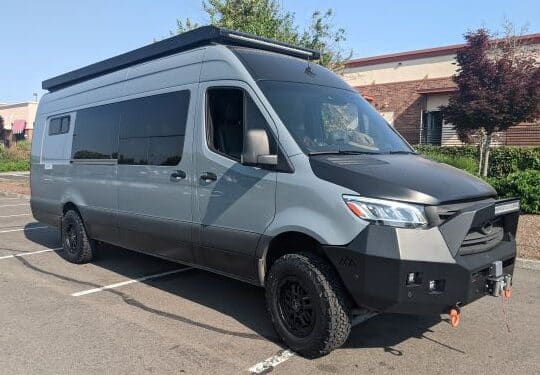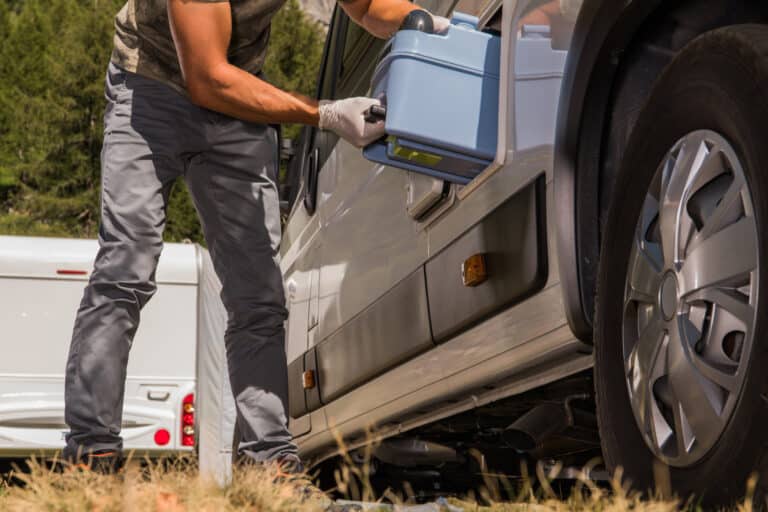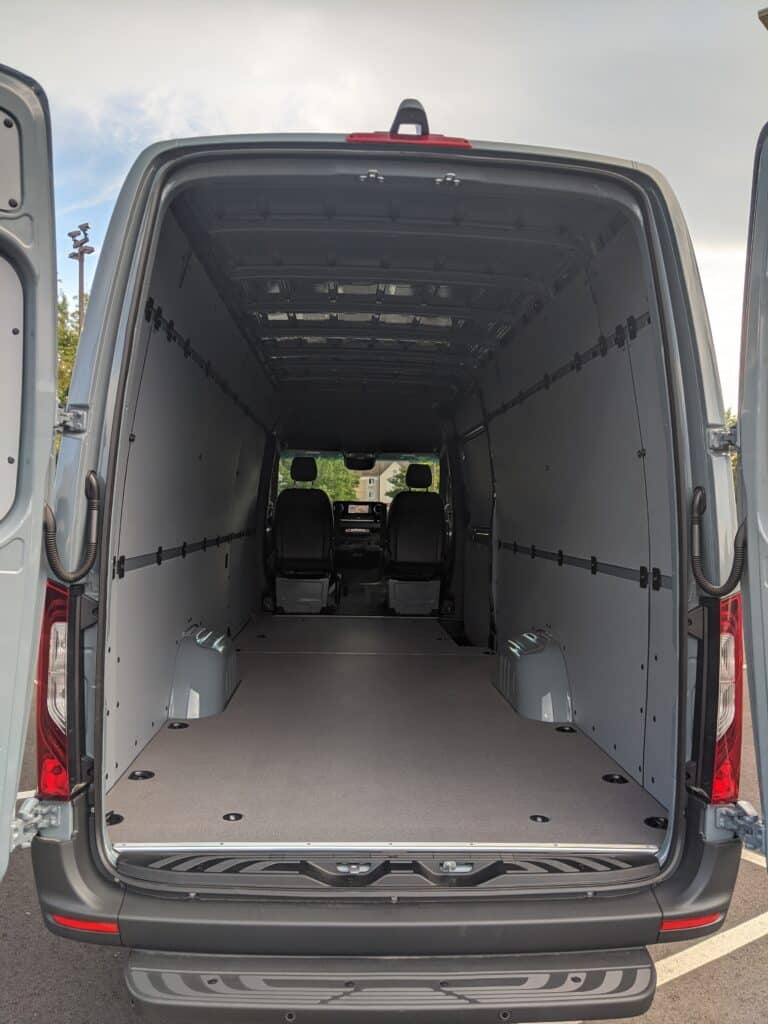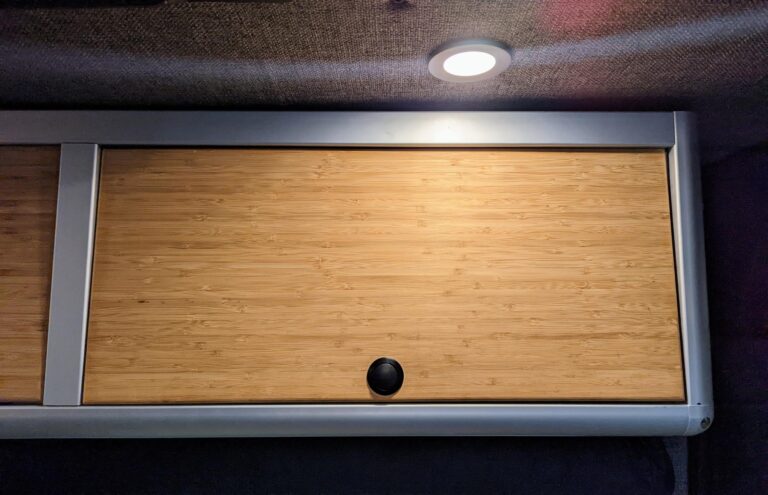Rolling in Style: Functional Design Tips for Van Life

Our content may include affiliate links, through which we earn a small commission on purchases. Want to learn more about us? Read here.
A van conversion is the process of converting a regular van, such as a cargo or passenger van, into a livable space. This involves customizing the van’s interior to make it functional for living or traveling purposes. Van conversions can range from basic and budget-friendly DIY projects to high-end custom builds with luxurious features.
Some standard features in van conversions include a bed, kitchenette, bathroom, seating area, and storage solutions. Van conversions have become increasingly popular in recent years as a way for people to live a mobile lifestyle and travel on their own terms. They can be used for everything from weekend camping trips to long-term travel and even full-time living.
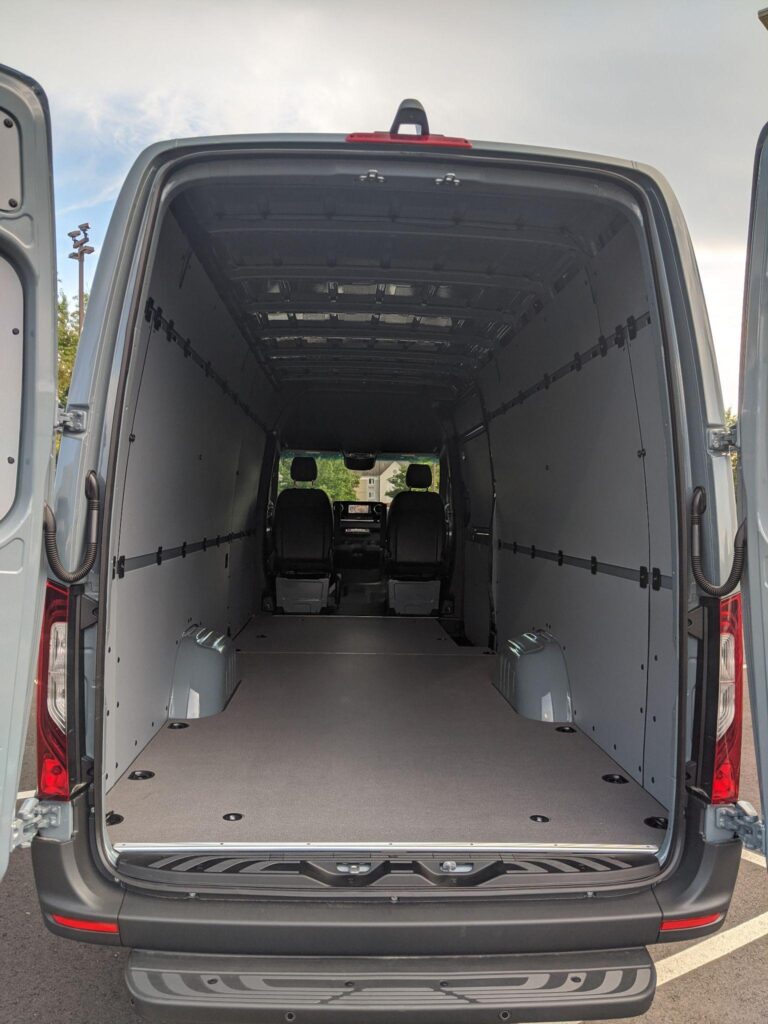
Cargo Van. So much space!
The interior design of a van build is crucial for several reasons. First and foremost, it needs to be functional, as the space should meet the needs of its occupants. A well-designed interior can maximize space and create a layout that is easy to use and navigate, making it a comfortable space to live or travel in.
In addition to functionality, the interior design of a van is also essential for its aesthetics. It should be visually appealing and reflect the owner’s personal style. Furthermore, a well-designed interior can increase the van’s resale value, as people are willing to pay more for a well-designed van with all the necessary features.
Finally, the interior design of a van can also impact its safety. A proper layout that doesn’t impede visibility or movement and securely stores items and equipment can help keep occupants safe on the road. Overall, the interior design of a van build is crucial in creating a vehicle that is enjoyable, practical, and safe to use.
Van conversions offer an excellent opportunity to create a livable space that suits your needs and preferences. There are several popular van conversion interiors, each with its features and benefits. One of the most popular layouts is the bed and kitchen layout, which places a bed at the rear of the van and a kitchenette and storage at the front.
Another popular option is the rear lounge layout, featuring a seating area that can convert into a bed and a kitchenette in the middle. The side kitchen layout features a kitchenette along one side of the van, with a bed at the rear and storage on the opposite side.
An all-in-one layout may include a convertible bed/seating area, a kitchenette, and a small bathroom. Finally, the high-top conversion layout features a raised roof, providing additional headroom and storage. Ultimately, the specific design and features chosen for a van build often depend on the van’s size, the traveler’s needs and preferences, and the budget for the conversion.
Layout Ideas
When it comes to camper van interiors, there is no one-size-fits-all solution. People choose designs based on their unique requirements, lifestyle, and aesthetic preferences. Some popular van build interiors have gained popularity among van dwellers.
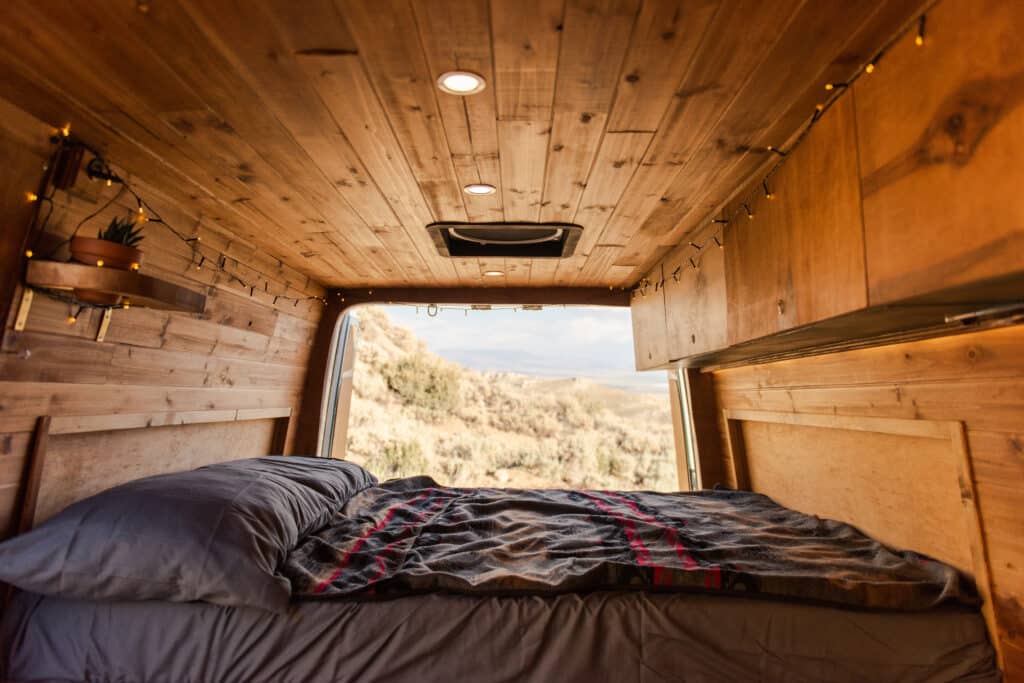
These designs are known for their functionality, comfort, and style. Whether you prefer a minimalistic and modern look or a cozy and rustic feel, there are plenty of options. Let’s look at some of the more popular van conversion interiors that can inspire your next van life adventure.
Bed and Kitchen Layout: This layout features a fixed bed at the rear of the van, with a kitchenette and storage space at the front. It’s a practical layout for those who prioritize cooking and sleeping.
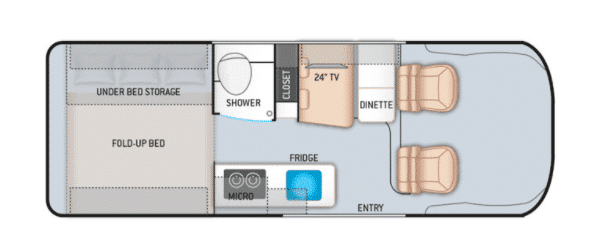
Van photo of interior front to back
Rear Lounge Layout: This layout features a rear seating area that can convert into a bed, with a kitchenette and storage space in the middle. It’s an excellent option for those who want a comfortable and social space to relax and entertain.
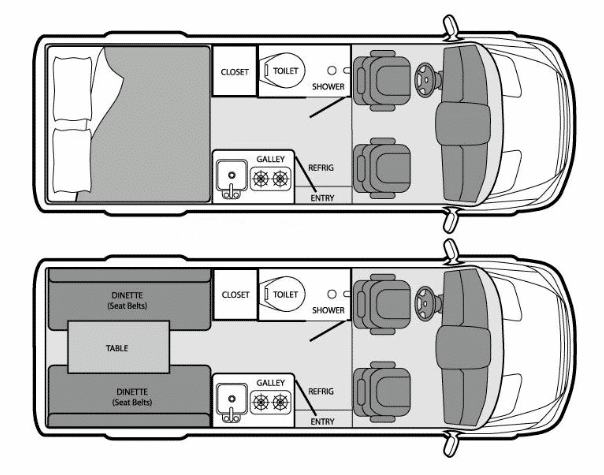
Side Kitchen Layout: This layout features a kitchenette along one side of the van, with a bed at the rear and storage space on the opposite side. It’s ideal for those who want to maximize kitchen space and prioritize a comfortable sleeping area.
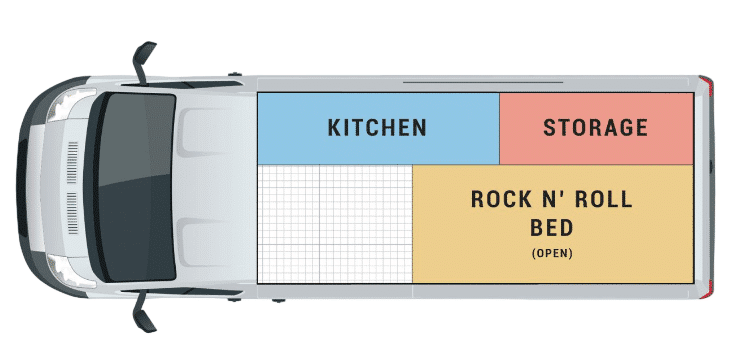
All-In-One Layout: This layout features a convertible bed/seating area, a kitchenette, and a small bathroom. It’s an excellent option for those who want a fully-equipped living space, particularly for long-term travel or smaller vans.
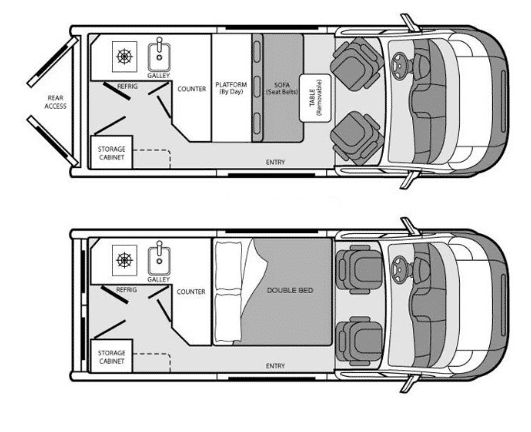
high roof Conversion: This layout features a raised roof, allowing additional headroom and storage space. It’s a popular option for creating a spacious, comfortable living space with ample storage.
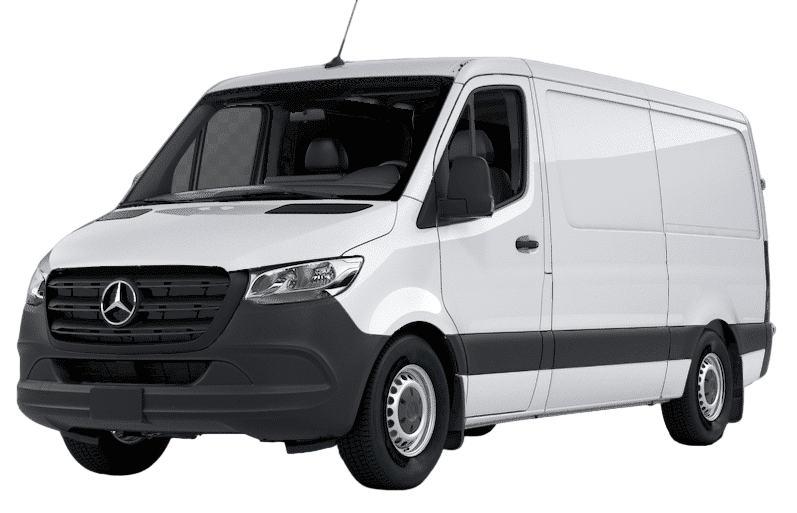
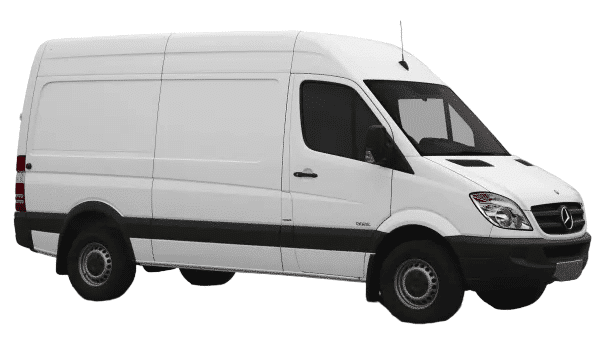
These are just a few examples of popular van conversion interiors. The chosen layout and features often depend on the van’s size, the traveler’s needs and preferences, and the budget for the conversion.
What are the Benefits and Drawbacks of Each Layout?
Bed and Kitchen Layout
Benefits
The bed and kitchen layout is famous for campervan conversions and offers several benefits. One of the main benefits is that it creates a clear separation between the living and sleeping areas, which can help to maximize space and create a more comfortable living environment.
Additionally, this layout provides ample storage space underneath the bed, which can be used for clothing, gear, or other items. The kitchen is often located near the rear of the van, providing easy access to the outdoors and creating a more open feel to the living area.
This layout can create a more visually appealing design, creating a clean and streamlined look for the van’s interior.
Drawbacks
While the bed and kitchen layout is a popular choice for van conversions, there are also some potential drawbacks. One of the main drawbacks is that it may need to provide more living space for some people, especially those who require a larger seating area or workspace.
Additionally, the kitchen may be located close to the sleeping area, which could be noisy or disruptive if one person cooks while the other sleeps. Another potential issue is that this layout can make it more difficult to access the rear of the van, which may be a problem if you need to load or unload large items.
Finally, the bed and kitchen layout can be more challenging to design and build than other layouts, as it requires careful consideration of the dimensions and placement of each component to ensure that they work together functionally and comfortably.
Rear Lounge Layout
Benefits
The rear lounge layout is popular for van conversions and offers several benefits. One of the main benefits is that it creates a large and comfortable living area that can be used for various activities, such as dining, working, or entertaining guests.
Additionally, this layout provides a panoramic view of the surrounding environment, which can be especially appealing if you plan to spend a lot of time parked in scenic locations. The lounge area (or bench seat) can also be easily converted into a sleeping area by adding a fold-down bed or convertible seating, which can help to maximize space and provide flexibility in how you use the van.
Finally, the rear lounge layout can create a more open and airy feel to the van’s interior, allowing for more natural light and a more spacious and inviting atmosphere.
Drawbacks
While the rear lounge layout has several benefits, it has some potential drawbacks. One of the main drawbacks is that it may require a larger van to accommodate the lounge area, which can limit your options if you prefer a smaller or more maneuverable vehicle.
Another potential issue is that the lounge area may take up valuable space that could be used for storage, a bathroom, or other essential features. Additionally, plan to use the van primarily for sleeping. The lounge area may not be as functional as a dedicated sleeping area or bed, making it less appealing for some van dwellers.
Finally, the rear lounge layout may require more complex and expensive construction, as it often involves custom cabinetry and seating arrangements that can be more challenging to install.
Side Kitchen Layout:
Benefits
While there are some drawbacks to a side kitchen van conversion layout, there are also several benefits. One of the main benefits is that it can provide a dedicated space for cooking and meal preparation, making van life more comfortable and convenient.
Additionally, a side kitchen can offer easy access to appliances from the cooking area, such as a refrigerator, stove, or sink. This layout can also create more efficient use of space by consolidating the kitchen and living areas into one side of the van, leaving more room for other activities on the opposite side.
Finally, a side kitchen layout can provide a more aesthetically pleasing design, creating a sleek and functional look for the van’s interior.
Drawbacks
One of the main drawbacks of a side kitchen van conversion layout is that it can take up valuable living space in the van. Since the kitchen is typically located on one side of the van, it can limit the open space for other activities, such as sleeping (Murphy bed or bunk beds may make more sense here to save space) or lounging.
Additionally, a side kitchen layout can make accessing storage or appliances from the opposite side of the van more difficult. Finally, a side kitchen may only suit some van conversions, as it may not work well with specific vehicle models or floor plans.
All-In-One Layout
Benefits
The all-in-one layout in a van conversion offers several benefits, making it a popular choice for many van dwellers. One of the main advantages is its compact size, which allows for versatile and efficient use of space.
With the kitchen, bed, and living area integrated into one space, the all-in-one layout maximizes storage and functionality, making it easy to move around and access everything you need without leaving the space. This layout can also offer greater flexibility in terms of design, allowing for more personalization and customization options.
The all-in-one layout can be more cost-effective than other layouts, as it often requires fewer materials and labor. Overall, the all-in-one layout can be an excellent choice for a minimalist and functional van conversion design that maximizes space and efficiency.
Drawbacks
The all-in-one layout in a van conversion typically refers to a design incorporating the bed (may be limited to a double bed), kitchen, and living space into a single area. One of the main drawbacks of this layout is that it can feel cramped and cluttered, as everything is in one space.
It may also be more challenging to keep the space organized and clean. Additionally, cooking smells and noise from the kitchen area may permeate the living and sleeping space, which can be unpleasant. Finally, the lack of separation between the living and sleeping areas can make it difficult to relax or sleep when someone else is cooking or working in the kitchen.
High Roof Layout
Benefits
The high roof layout in a van conversion has several benefits, making it a popular choice for many van dwellers. One of the primary benefits is the additional headroom that a high roof provides, which can make the interior feel more spacious and comfortable.
This can be particularly important for taller individuals or those who plan to spend extended periods of time in the van. Additionally, the raised ceiling allows additional storage or the option to install features like a shower or toilet, which may not be possible in a lower-profile van.
The high roof also provides more room for custom cabinetry and storage solutions, which can help maximize the available space in the van. Finally, a high roof can give a more aerodynamic profile on the road, improving fuel efficiency and handling compared to larger, boxier vans.
Drawbacks
While the high roof layout in a van conversion offers many benefits, it also has potential drawbacks. One of the primary drawbacks is the increased cost of purchasing or converting a high roof van compared to a standard-height van.
The additional height can make the van less maneuverable in certain situations, such as low bridges or tight parking spots. The high roof’s added weight and wind resistance can also decrease the van’s overall fuel efficiency and handling, especially at higher speeds.
Finally, the added height may limit the van’s access to some parking garages or other indoor spaces, which can be a consideration for urban dwellers or those who plan to travel in areas with low clearance.
Creative Storage Solutions
Van conversions are about making the most of such a small space, meaning creative storage solutions are essential. Whether planning a long-term road trip or just wanting a comfortable and functional space for weekend getaways, optimizing storage is crucial to maximizing your van conversion.
With limited space available, every inch counts, and finding ways to store your belongings efficiently can be challenging. Fortunately, many creative storage ideas can help you make the most of your van’s interior, including custom overhead cabinets and shelves, under-bed storage compartments, and modular storage systems.
By utilizing these ideas, you can create a space that is not only functional but also aesthetically pleasing and reflective of your personal style.
Overhead Storage: Use overhead shelves or cabinets to store lightweight items such as clothing, bedding, and kitchenware. This helps to maximize the use of vertical space in the van.
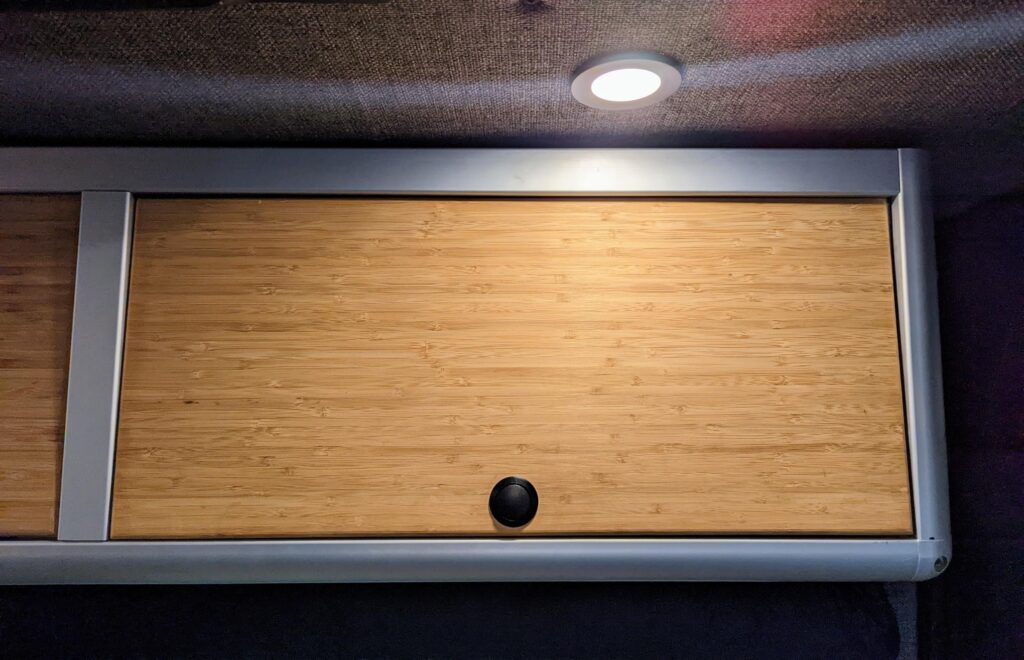
and bamboo plywood finish
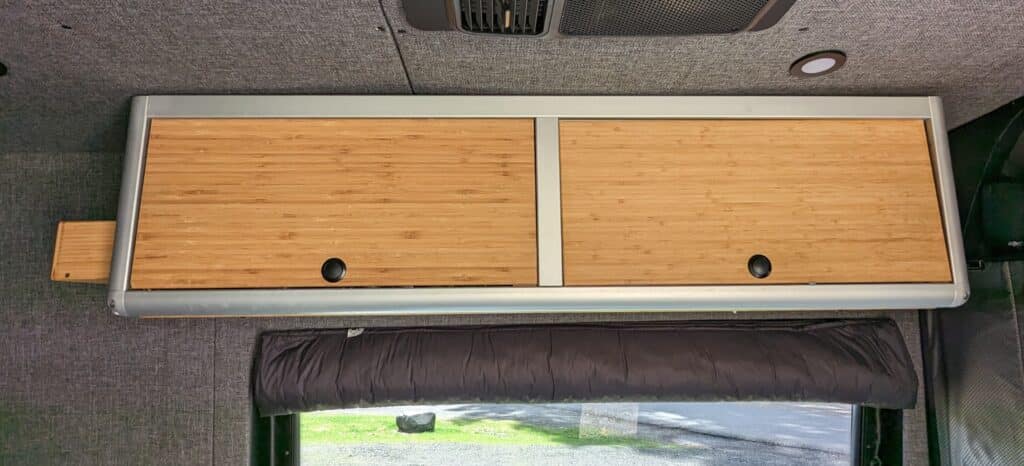
Under-Bed Storage: A bed in a van conversion can also serve as storage. Use storage boxes or pull-out drawers underneath the bed to store larger items such as camping gear, tools, or outdoor equipment.
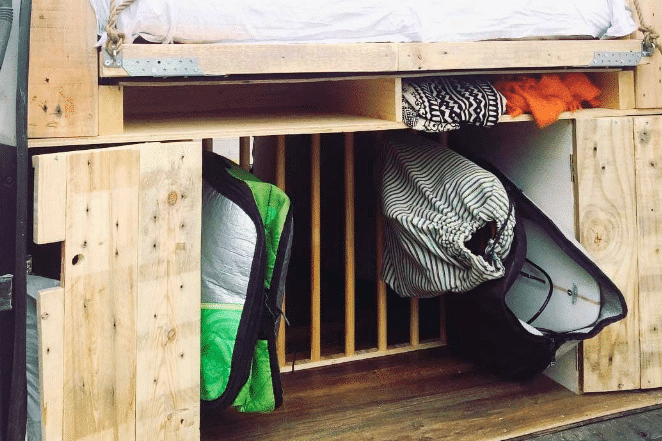
Kitchen Cabinet Storage: Design your kitchen cabinets with multiple layers of shelving or sliding drawers to store kitchen items such as pots, pans, cutting board, and utensils. Consider using a pegboard or magnet board to organize smaller items and keep them within easy reach.
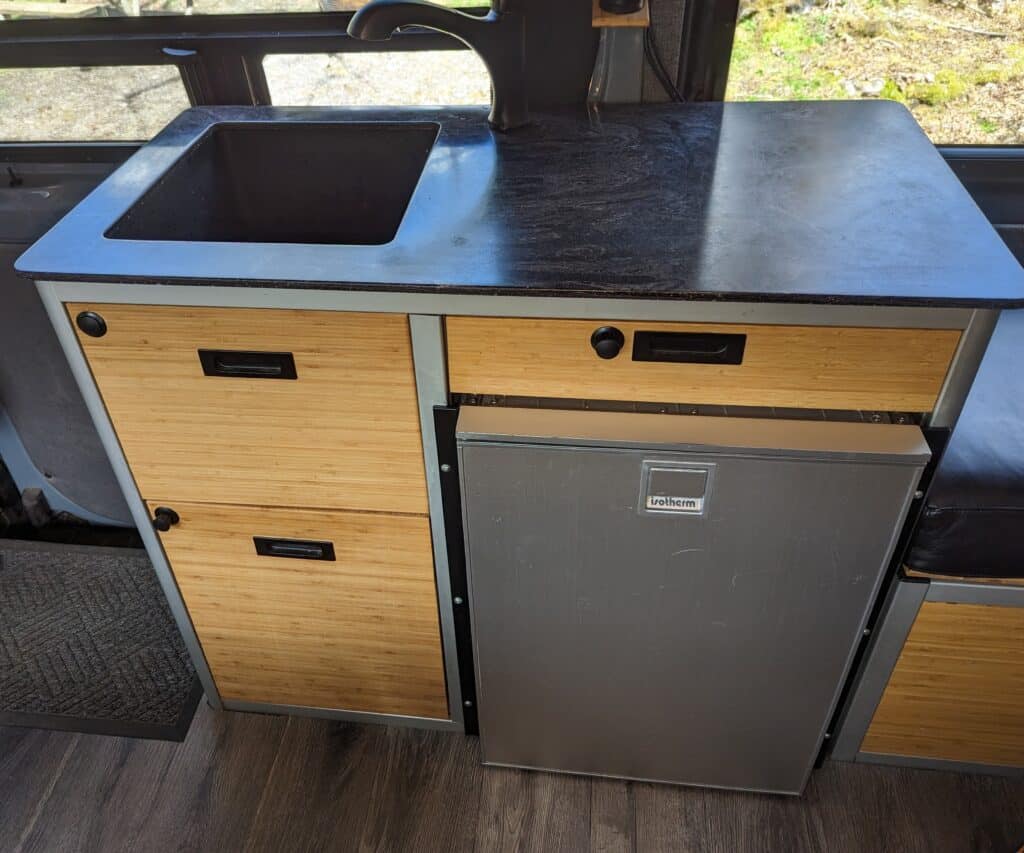
Wall-mounted Storage: Use wall-mounted baskets, shelves, or hooks to store items such as shoes, hats, or jackets. This helps to keep clutter off the floor and saves valuable floor space.
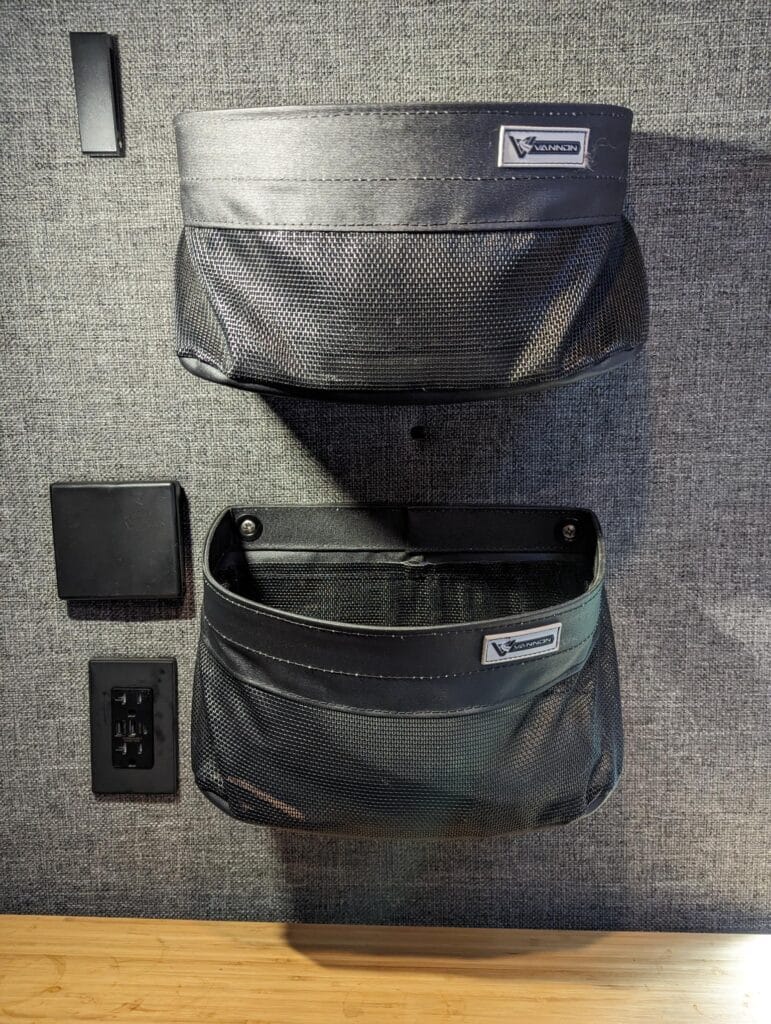
Hidden Storage: Consider installing hidden storage compartments in the van’s walls or under benches. These can be used to store valuables or items that must be kept secure.
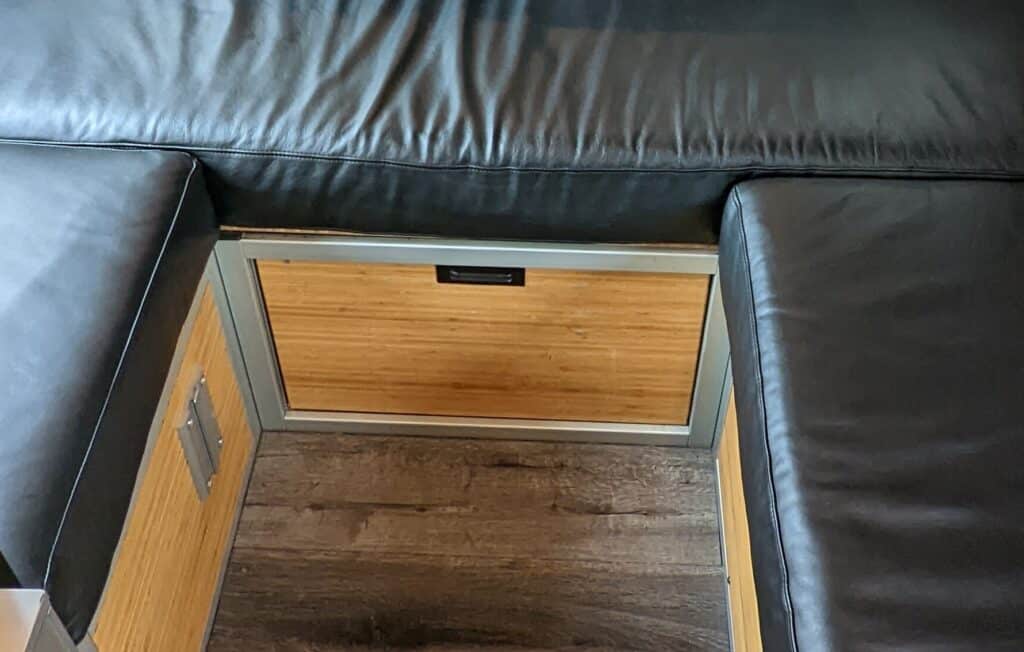
Break-Down Tables: Incorporate break or fold-down tables into your design to maximize space efficiency. These tables can be used for dining, as a computer work space, or maybe for an evening card game and can be easily stored away when not in use.
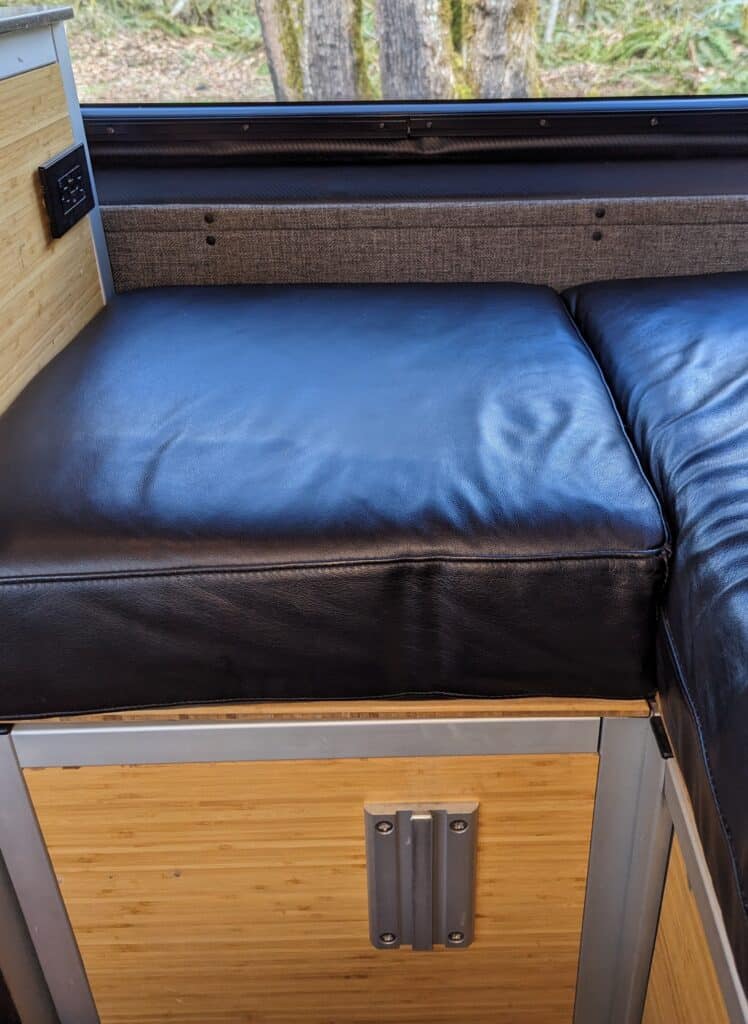
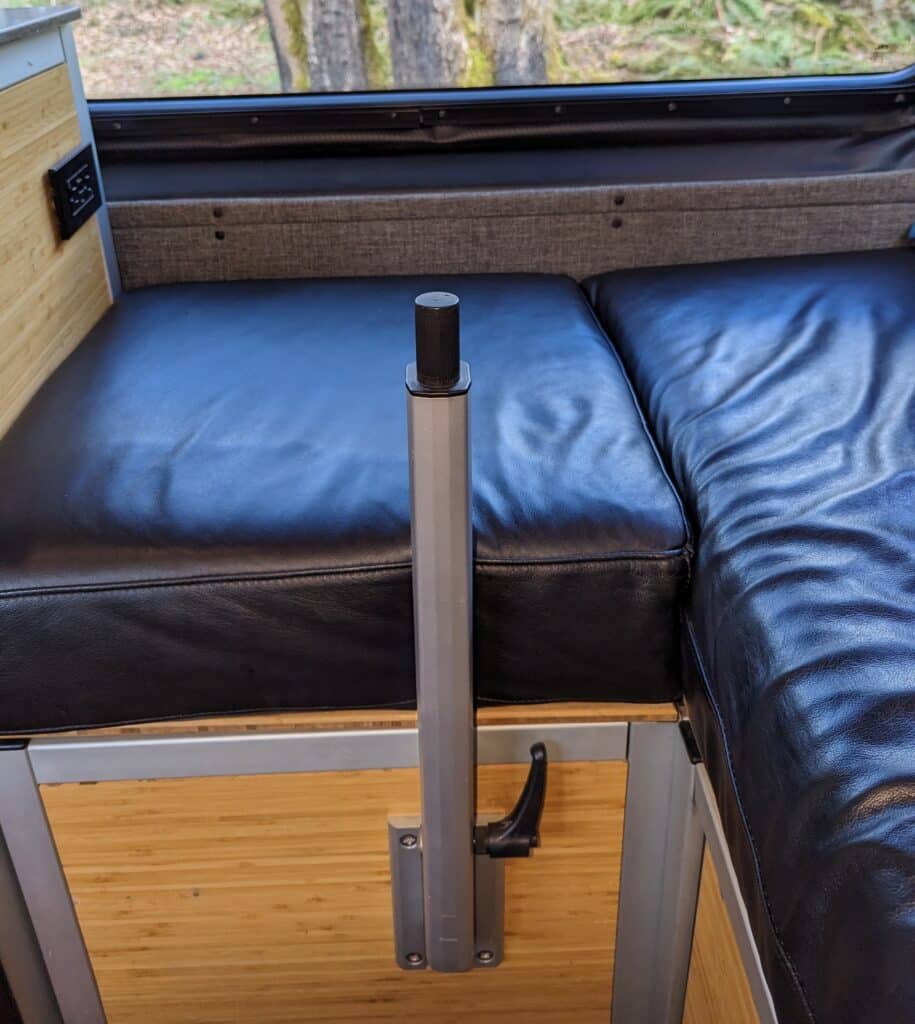
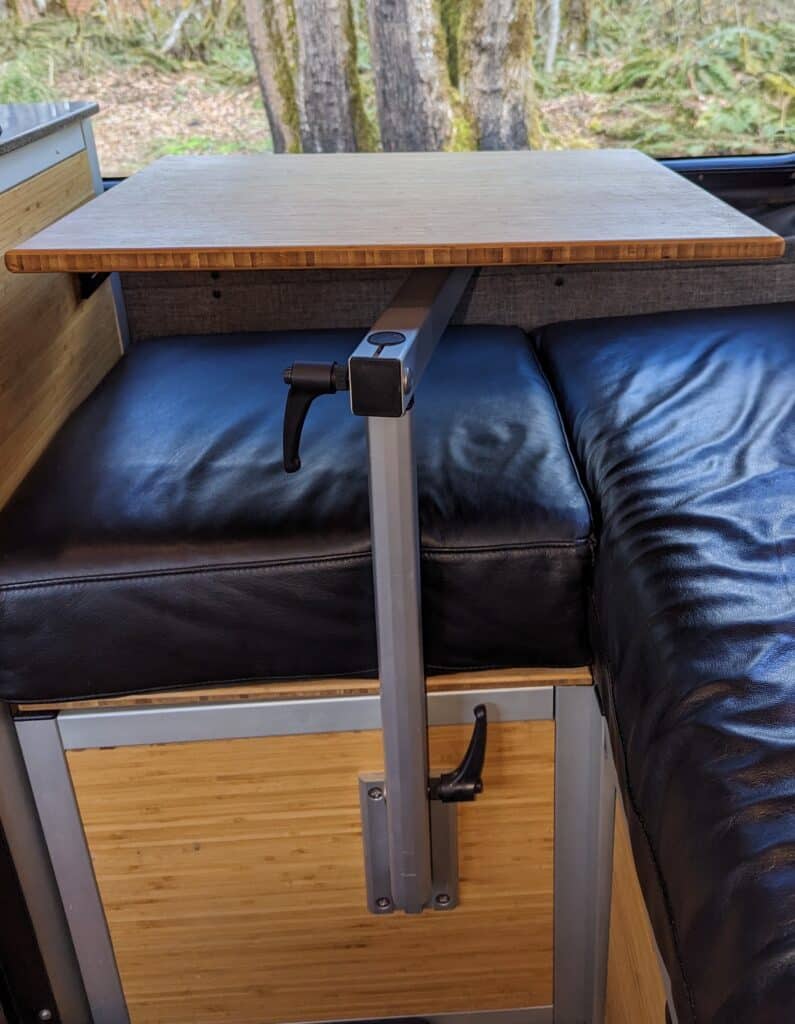
Elevated Beds: An elevated Bed can create additional storage underneath. This can store more oversized items such as bikes, surfboards, or outdoor gear.
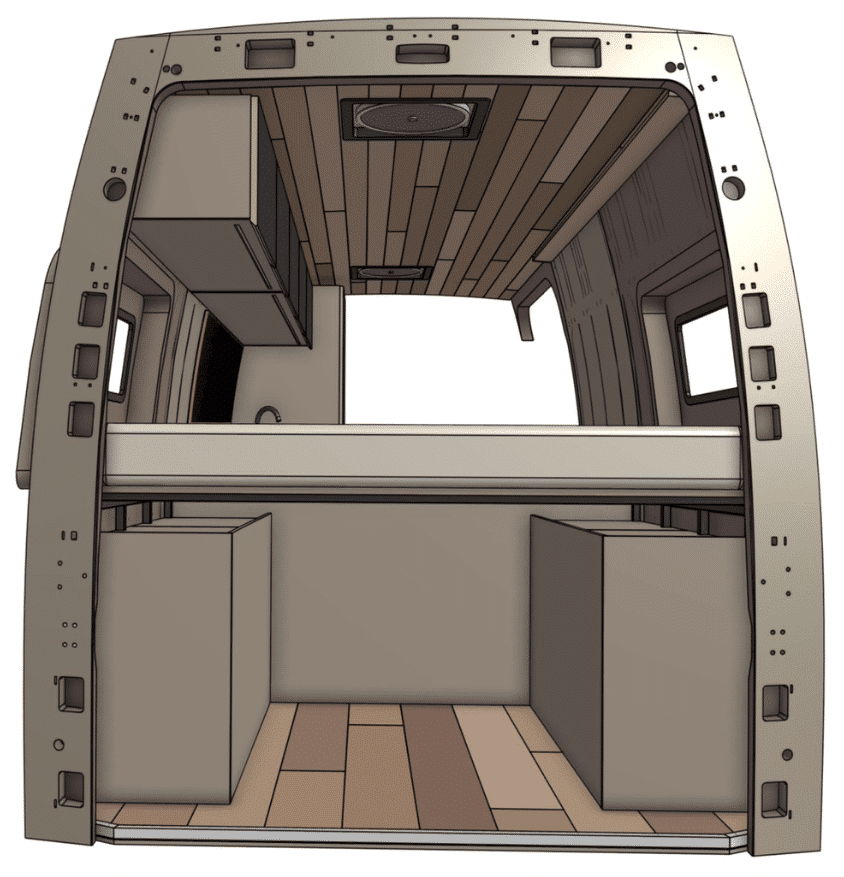
Creating efficient storage space in van conversion is crucial because the available space is limited. A van is a compact space; every inch must be utilized effectively to create a comfortable and functional living area. Efficient storage space helps to keep the interior organized, clutter-free, and aesthetically pleasing.
When everything has its designated place, keeping track of items and finding what you need quickly is easier. Additionally, efficient storage can improve the overall functionality of the van by allowing for more freedom of movement and living space. The interior can quickly become cramped, uncomfortable, and unusable without proper storage solutions.
Ultimately, creating efficient storage space in a van conversion is essential to maximizing its functionality and making it an enjoyable living space for extended periods.
Design Ideas
Many popular color schemes and material choices for van conversions can make the space stylish and functional. One popular color scheme is a neutral palette of whites, grays, and natural wood tones. This creates a clean and modern look allowing easy customization with pops of color. Another popular option is a bohemian-inspired color scheme with rich earthy tones, patterns, and textures.
As for material choices, many van conversions incorporate durable and easy-to-clean materials such as vinyl or laminate (tip: when doing flooring, do the entire floor. less intricate cuts this way), reclaimed wood flooring, waterproof upholstery fabrics, and lightweight wood alternatives like bamboo or engineered wood. Additionally, many van conversions incorporate natural materials like wood or stone to add a touch of warmth and texture to the space.
For several reasons, using durable and easy-to-clean materials in a van conversion is essential. First, van life can be rugged and unpredictable, and the materials used must be able to withstand wear and tear.

Second, a van’s interior is exposed to various environmental factors, such as humidity, temperature changes, and sunlight, which can cause damage over time. Using durable materials ensures that the interior remains in good condition despite these conditions.
Additionally, van life involves spending extended periods in a small space, and keeping the living area clean and hygienic is essential. Easy-to-clean materials, such as vinyl or linoleum flooring, make maintaining the interior’s cleanliness and hygiene easier. Spills, dirt, and dust can be wiped away quickly, and the interior can be disinfected regularly.
Moreover, using durable and easy-to-clean materials can improve the van’s resale value. Buyers are likely to be more attracted to a van with an interior that is in good condition and easy to maintain. Conversely, a van with a shabby interior or materials that have worn out quickly will likely have a lower resale value.
In summary, using durable and easy-to-clean materials in a van conversion is essential for the longevity of the interior, maintaining hygiene, and improving resale value. Choosing materials that can withstand the challenges of van life while being easy to maintain and clean is crucial.
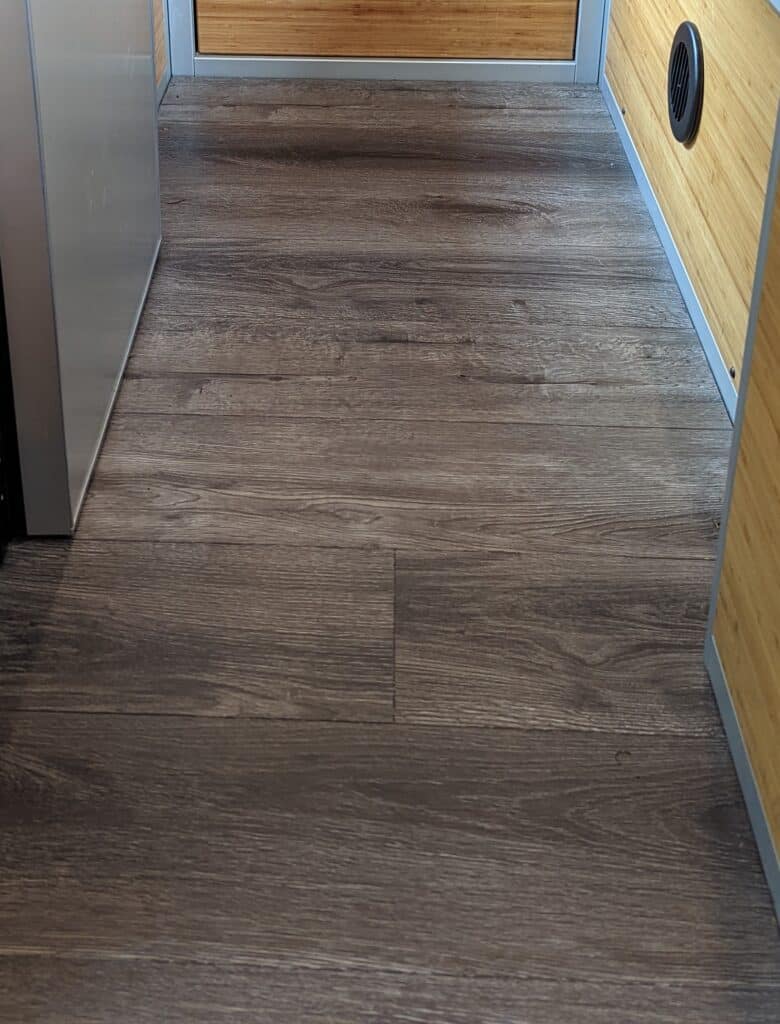
functional and stylish
Technology Upgrade Ideas
When it comes to campervan conversions, technological upgrades can play a significant role in enhancing the overall living experience. Using modern technology, van owners can make their living space more comfortable and convenient.
For instance, installing solar panels and lithium-ion batteries can provide reliable and sustainable power for various appliances and devices, allowing van dwellers to stay off-grid for extended periods. In addition, adding smart home devices such as thermostats, lighting, and security systems can significantly improve the convenience and safety of the van’s living space.
With these upgrades, van dwellers can remotely monitor their van’s temperature, lighting, and security from a smartphone or tablet. Other technological upgrades for van conversions include Wi-Fi routers, mobile hotspots, and entertainment systems, which can provide reliable internet connectivity and entertainment options for long journeys.
Overall, incorporating technological upgrades into a van conversion can enhance the living space’s functionality, comfort, and convenience. Check out some of these items below:
Mobile Hotspot: A mobile hotspot can provide internet connectivity to the van, allowing access to online resources, entertainment, and communication.
Security System: A security system can include features such as cameras, motion detectors, and alarms, providing peace of mind and enhancing safety.
Smart Home System: A smart home system can control various van functions, such as lighting, temperature, and entertainment, through a mobile device or voice commands.
Backup Camera: A backup camera can assist with parking and maneuvering the van in tight spaces.
GPS Navigation: A GPS navigation system can help with route planning and navigation, especially for long-distance travel.
Battery Management System: A battery management system can monitor and optimize the power usage of the electrical system, ensuring efficient power consumption and extending the battery’s lifespan.
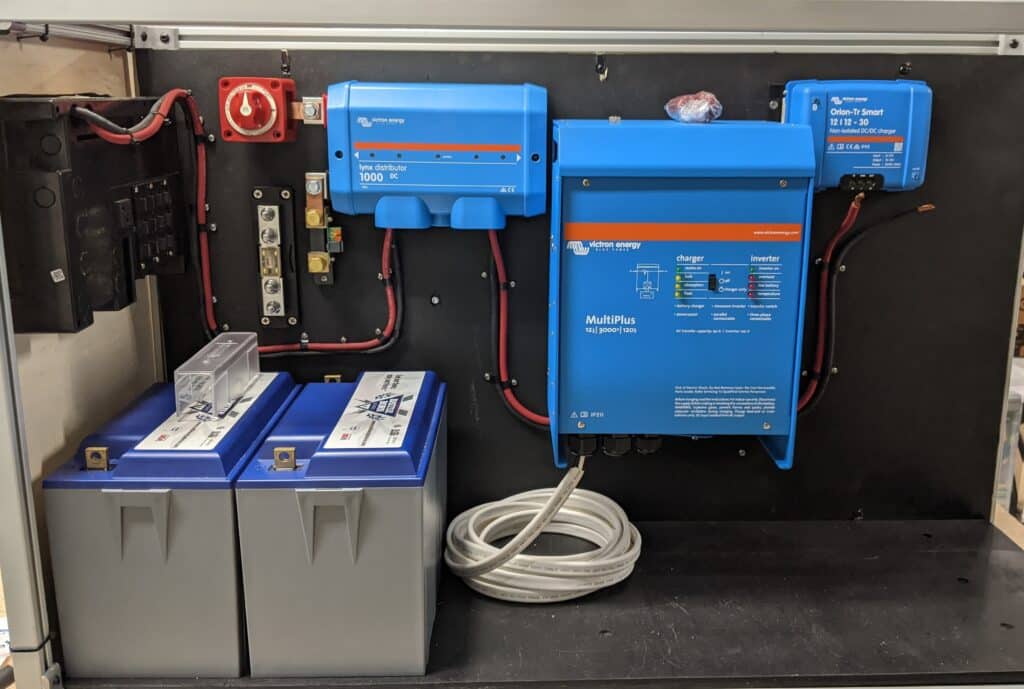
Smart Thermostat: A smart thermostat can regulate the interior temperature and optimize energy consumption, providing a comfortable living environment while minimizing power usage.

Van Life Tech
Automatic/Manual Awning: An automatic or manual awning is a great idea for a van conversion because it provides shade and protection from the elements while allowing you to enjoy the outdoors. With an awning, you can create an outdoor living space and extend your living area beyond the confines of your van.
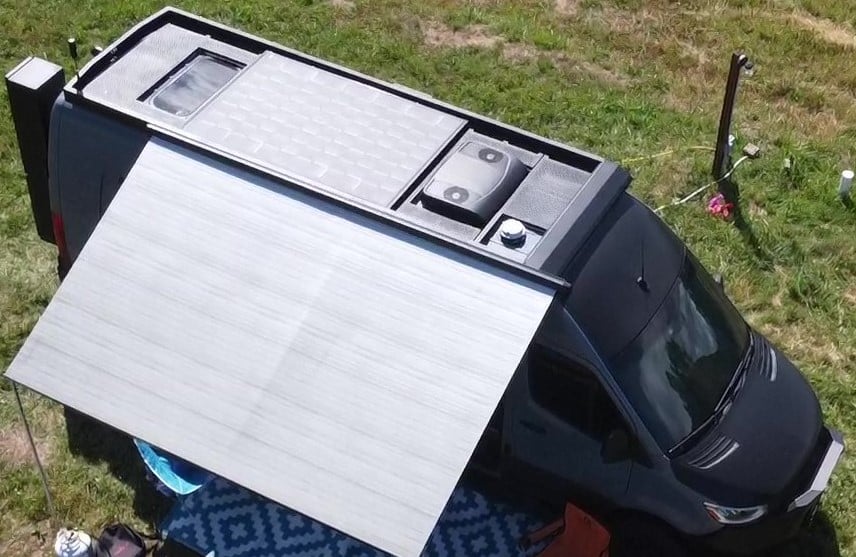
living space and 500w Solar.
Solar Panels: These are popular technological upgrades for van conversions. Solar can provide a reliable and renewable energy source, powering the van’s electrical system and reducing the reliance on traditional power sources. This can be especially useful for van dwellers who spend much time off-grid in remote areas or national parks, where conventional power sources may not be available.
These technological upgrades can improve the van conversion experience, providing comfort, convenience, and safety. Researching and choosing upgrades that fit one’s needs, preferences, and budget is essential.
Personalization Ideas
Personal touches in a van conversion can make the space feel like home and reflect the individual’s personality and style. Here are some examples of personal touches that people can do in a van conversion:
Decorations: Adding decorations such as wall art, throw pillows, or curtains can bring color and personality to the living space.
Customized Cabinets: Customizing cabinets with unique designs, colors, or hardware can add a personal touch and make the space feel more customized.
Photos and Memorabilia: Displaying personal photographs, memorabilia, or souvenirs from travels can create a sense of nostalgia and add a personal touch.
Plants: Adding plants or flowers can create a sense of freshness and natural beauty and help purify the air.
Customized Lighting: Customizing the lighting with colored or dimmable LED lights can create a cozy and personalized atmosphere.
Customized Bedding: Customizing bedding with unique patterns or colors can add a personal touch and create a comfortable and inviting sleeping area.
Customized Flooring: Choosing unique or eco-friendly materials, such as bamboo or cork, can add a personal touch and create a cozy and inviting living space.
Customized Storage: Adding customized storage solutions, such as hidden compartments or unique storage containers, can create a sense of uniqueness and practicality.
These personal touches can enhance the livability and comfort of the van conversion, making it feel like a home away from home. Prioritizing personal preferences and style when designing and customizing a van conversion is essential to create a functional and personalized space.
Final Thoughts
The above responses highlight various interior design ideas and upgrades for van conversions. These include creative solutions such as under-bed storage and modular cabinets, durable and easy-to-clean materials, and personal touches such as decorations, customized cabinets, and bedding.
Technological upgrades such as solar, a mobile hotspot, and smart home systems can enhance the living space’s comfort, convenience, and safety. Popular interior designs for van conversions include minimalist, industrial, and bohemian styles.
Overall, interior design plays a crucial role in creating a comfortable and functional living space in a van conversion, and it’s essential to consider personal preferences, lifestyle, and budget when designing and customizing the space.
Sharing amazing campervan interior ideas and photos can foster van life inspiration among van dwellers, spark creativity, and provide valuable insights into making the most of limited space. By sharing your campervan interiors and photos, you can showcase your personal style, offer tips and suggestions, and contribute to the van lifers community.
Seeing how others have designed and customized their living spaces can also help you generate new ideas and solutions for your own van conversion. Don’t hesitate to share your amazing camper van interior photos on social media platforms, online forums, or with friends and family.
Your photos can inspire and motivate others to pursue their own van life dreams while also providing a glimpse into the unique and rewarding lifestyle of van dwelling.
So, please post your awesome photos on any or all of our social media channels above. Thank you, and safe travels!



